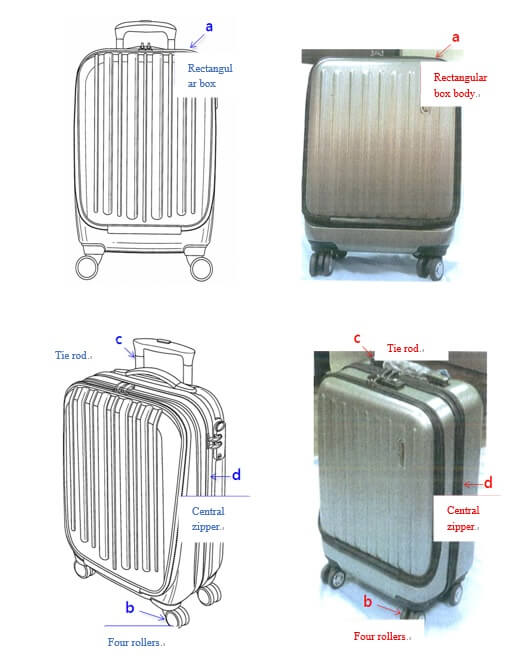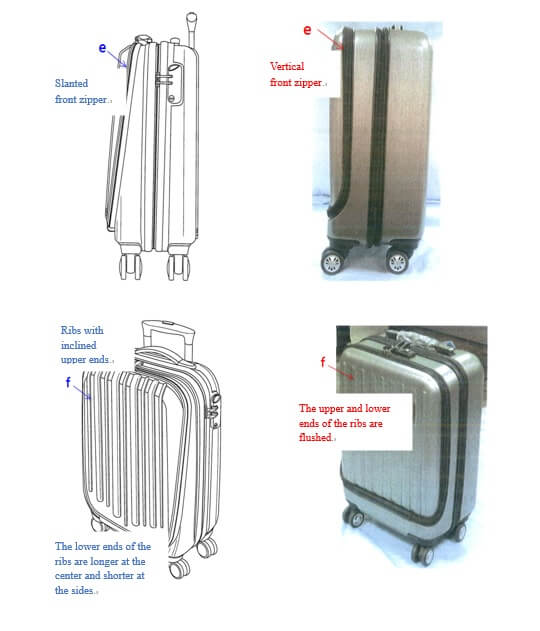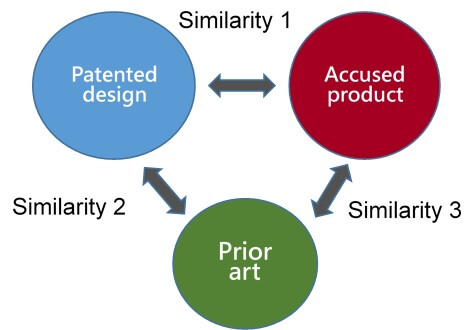More Details
After a patent application is granted, the interpretation of its scope and whether an allegedly infringing product falls within the scope of the patent is very important to the patentee and any interested party. In addition, the scope of a granted patent is based on the drawings, and the description of the specification can be used as a reference. In Taiwan, the judgment of whether an allegedly infringing product falls within the scope of a patent usually follows the rules stated in the “Directions for the Determination of Patent Infringement” published by the Taiwan Intellectual Property Office (hereinafter referred to as the “TIPO”) in 2016. This article will introduce the principles stated in the Directions.
The guidelines for determining whether an accused product falls into the scope of the design patent at issue is stated in Chapter II “Infringement Analysis for Design Patent” of the “Directions for the Determination of Patent Infringement.” The procedure for determining infringement is a two-step process comprising the first step of “constructions of the design patent right” and the second step of “comparison of the constructed scope of the design patent right and the allegedly infringing product and the determination of infringement.” Based on the “Directions for the Determination of Patent Infringement,” the two-step process is as shown in Annex I[1].
I. The first step: “constructions of the design patent right”
Paragraph I of Article 121 of the Patent Act stipulates that “‘Design’ means the creation made in respect of the shape, pattern, color, or any combination thereof, of an article as a whole or in part by visual appeal.” Furthermore, according to Paragraph II of Article 136 of the Patent Act, “The extent of the protection conferred by a design patent shall be determined by the drawing(s), and the description may be considered as a reference.” Accordingly, the design patent right shall be constructed based on the appearance of the article to which the design is applied as shown in the drawings of the design patent and the article.
In this step, as the scope of the design patent right is determined based on the overall appearance in the published drawings of the granted design patent, the description of the specification of the design patent may be taken into consideration so as to reasonably determine the scope of the design patent right. According to the “Directions for the Determination of Patent Infringement,” the method of drafting the drawings may also be considered to determine the scope of patent right. For example, broken lines in the drawings may be the basis for constructing the scope, the prosecution history may relate to the interpretation of the protection scope, and the features of the design may be classified into functional and ornamental features.
For ascertaining the article to which the design is applied, the drawings of the design patent shall be the primary consideration and the title of the design and the use of the product as stated in the design patent shall further be considered. For ascertaining the appearance of the design, the overall appearance formed by the shapes, patterns and colors disclosed in the drawings shall be the basis; and the description of the specification may also be considered, if necessary[2].
II. The second step “comparison of the constructed scope of the design patent right and the allegedly infringing product and the determination of infringement”
After the construction of the scope of the patented design, the contents of the accused product are analyzed in view of the constructed patent scope and the comparison of the patent scope and the analyzed contents of the accused product is made. In this step, comparison between the scope of the design patent constructed in the first step and the contents of the accused product is made by adopting the perspective of an ordinary observer. This so-called “ordinary observer” is “a hypothetical person whose perspective is used to assess whether a patented design is infringed by the accused product.” The ordinary observer has a common level of knowledge and understanding of the product relating to the design patent, is reasonably familiar with the product, and can reasonably judge the differences and similarities between the accused infringing product and the patented design with reference to prior arts; an ordinary observer, however, is not an expert or professional designer who is familiar with the production and sales of the product. Where the ordinary observer deems that the accused design and claimed design are substantially the same, then infringement is found.[3]
The accused product is analyzed in view of the patent scope constructed in the first step. The contents of the analyzed accused product are then compared to the scope of the design patent. In this respect, three aspects shall be considered, i.e., “whether the accused product and the article to which the patented design is applied are identical or similar,” “whether the appearances of the accused product and the patented design are identical or similar,” and “prosecution history estoppel or prior art defense.”
1. Whether the accused product and the article to which the patented design is applied are identical or similar
To determine whether the accused product is identical or similar to the article of the design patent, the judgment is made based on whether the use of the accused product is identical or similar to the article to which the patented design is applied. The determination of whether the accused product is identical or similar to the patented design is usually made based on the perspective of an “ordinary observer.” Generally, based on the “Directions for the Determination of Patent Infringement,” identical products refer to those with the same uses, and similar products refer to those with similar uses. An ordinary observer should simulate a situation of actually purchasing and using the products as well as consider the sales status of the products.[4]
In most cases, the determination shall be made based on the perspective of an ordinary observer. Taking a motorcycle and an electric bicycle as examples, the Intellectual Property Court deemed that both of the motorcycle and the electric bicycle are directed to a two-wheel transportation vehicle since the difference is only the source for providing power and thus the uses of the two are identical. However, the Civil Judgment of the Intellectual Property Court 105 (2016) Ming Juan Hsu Tzu No. 62 provides a different opinion. In this judgment, the determination of whether the product items are identical or similar was made based on the perspectives of the creators, but not an ordinary observer. The court explained that the result of the determination would be different due to the different classification of the products; and the dispute could not be resolved by the ordinary observer test. When analyzing whether the accused product is identical or similar to the article to which the patented design is applied, the determination should not be based on this category but should be made based on whether the creator of the design can easily transfer the design of the patent at issue to the allegedly infringing product.[5]
The foregoing judgment adopts the “perspective of the creator” to judge whether the accused product is identical or similar to the product to which the protected design is applied. Such judgment enhances the scope of protection of a design patent. However, whether such “perspective of the creator” will be generally adopted by the courts for subsequent judgments remains to be seen.
2. Whether the appearances of the accused product and the patented design are identical or similar
(1) Direct observation and comparison
In assessing whether the appearance of the accused product is identical or similar to the patented design, in principle, an ordinary observer should make direct observation and comparison with the naked eye, and avoid the use of instrumental observation to magnify subtle differences; and the ambiguity obtained from different time, different places and isolated observations should not be used. However, if an ordinary observer usually have to use equipment to observe and compare the purchased products, such equipment may be used.
(2) Overall observation, comprehensive judgment
The fictional person who determines whether appearances are identical or similar is also an ordinary observer. The judgment should be based on the viewpoint of an ordinary observer when purchasing the products; i.e., an ordinary observer who pays general attention to the products, and observes and compares the overall appearances of the design patent at issue with the accused infringing product by means of overall observation and comprehensive judgment. If an ordinary observer is confused by the visual impression of the patent at issue and the accused product, then the overall appearance of the two is deemed to be similar.[6] The features that easily attract the attention of an ordinary observer, such as “the design features of the patented design that are obviously different from the prior art” and “the parts that are easy to see during normal use,” should be given greater weight since they can greatly affect the overall visual impression of the design. In addition, the overall contents of the shapes, patterns, and colors disclosed in the descriptions and drawings of the design patent and the corresponding contents in the accused product must be taken into consideration based on the principles of overall observation and comprehensive judgment. Factors such as the nature of the patented design, functional features and prior art may also have an impact on the appearance comparison.
In practice, when judging the appearances of the patent at issue and the accused product, the Intellectual Property Court usually determines the differences and similarities of the patent at issue and the accused product and considers the weighting of the differences and similarities on the overall impressions and then decides whether the patent at issue and the accused product are similar.
For example, the Civil Judgment of the Intellectual Property Court 105 (2016) Ming Juan Hsu Tzu No. 81 used the foregoing principle to determine whether the appearances of the patent at issue and the accused product are similar.
The features in common

The different features

In the judgment, the court pointed out that the “parts that are easy to be seen during normal use” of a luggage product are not limited to the front part of the luggage; the features on the sides and top of the luggage are also the parts that an ordinary observer would pay attention to when purchasing or using the product. The plaintiff claimed that the feature of the accused product “slanted front zipper” is only a minor difference that will not affect the overall visual impression; however, such argument was not accepted. The court indicated that although the ribs of the front part of the accused product and the patented design are all straight up and down, wide and narrow, the upper end of the rib of the patent design is inclined along the shape of the shell, and the lower end is longer in the middle and on both sides, whereby the arrangement is slightly shorter; however, the upper and lower ribs of the accused product are arranged in a straight shape, and the upper end is not bent, so there are differences in the rib arrangement on the front panel surface in the accused product and the patented design. Accordingly, the judgment pointed out that the appearance of the patent at issue and the allegedly infringing product are not similar.
(3) Three-way visual comparison
In the “Directions for the Determination of Patent Infringement” revised in 2016, the “three-way visual comparison” was introduced. The “three-way visual comparison” is an auxiliary approach for determining the similarity of the patent at issue and the accused product. This approach is particularly suitable for situations when the patent at issue and the accused product are not plainly dissimilar. In this approach, as shown below, the degrees of similarity among the “patented design,” the “accused design” and the “closest prior art” are compared and analyzed.

Where the degree of similarity between the patented design and the accused product is higher than that between the patented design and the closest prior art, and if the similarity is also higher than that between the accused product and the closest prior art, then the appearance of the accused product is deemed similar to the appearance of the patented design.[7] However, it shall be noted that the “three-way visual comparison” is not suitable for a situation where the patented design and the accused product are obviously similar based on the foregoing “overall observation, comprehensive judgment.” For example, the Civil Judgment of the Intellectual Property Court 108 (2019) Ming Juan Hsu Tzu No. 47 explains that when the accused product and the patented design are obviously similar or dissimilar based on the “overall observation, comprehensive judgment,” then the “three-way visual comparison” is not applicable.
3. Prosecution history estoppel and prior art defense.
The available defenses for an accused infringer are prosecution history estoppel or prior art defense. The accused infringer may use prosecution history estoppel or prior art defense, if applicable, to defend that the accused product does not fall into the scope of the design patent and infringement is not found. If the similar portions of the accused product and the patented design belong to items that are limited, abandoned or excluded from the patent scope during the prosecution of the patent application, then prosecution history estoppel is applicable; this would be the case even though in the other steps it is decided that the accused product and the patented design are similar. Furthermore, if evidence proving that the accused product is identical or similar to the prior art is found, the prior art defense is applicable and no infringement is found.
Ever since the TIPO published the “Directions for the Determination of Patent Infringement” in 2016, most of the judgments made by the Intellectual Property Court (Intellectual Property and Commercial Court) generally follow the Directions. Therefore, it is essential for patentees, interested parties or the public to understand the Directions.
*Assistant Manager of International Patent Division at Tai E International Patent & Law Office
[1] “Directions for the Determination of Patent Infringement” published by the TIPO in 2016, page 61.
[2] “Directions for the Determination of Patent Infringement,” pages 66~75.
[3] “Directions for the Determination of Patent Infringement,” page 76.
[4] “Directions for the Determination of Patent Infringement,” pages 77~78.
[5] The slideshow of “Design Patent Seminar 2021,” page 103.
[6] “Directions for the Determination of Patent Infringement,” page 78.
[7] “Directions for the Determination of Patent Infringement,” page 80.









